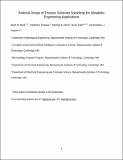Rational design of thiolase substrate specificity for metabolic engineering applications
Author(s)
Bonk, Brian M; Tarasova, Yekaterina; Hicks, Michael A; Tidor, Bruce; Prather, Kristala LJ
DownloadAccepted version (2.979Mb)
Terms of use
Metadata
Show full item recordAbstract
© 2018 Wiley Periodicals, Inc. Metabolic engineering efforts require enzymes that are both highly active and specific toward the synthesis of a desired output product to be commercially feasible. The 3-hydroxyacid (3HA) pathway, also known as the reverse β-oxidation or coenzyme-A-dependent chain-elongation pathway, can allow for the synthesis of dozens of useful compounds of various chain lengths and functionalities. However, this pathway suffers from byproduct formation, which lowers the yields of the desired longer chain products, as well as increases downstream separation costs. The thiolase enzyme catalyzes the first reaction in this pathway, and its substrate specificity at each of its two catalytic steps sets the chain length and composition of the chemical scaffold upon which the other downstream enzymes act. However, there have been few attempts reported in the literature to rationally engineer thiolase substrate specificity. In this study, we present a model-guided, rational design study of ordered substrate binding applied to two biosynthetic thiolases, with the goal of increasing the ratio of C6/C4 products formed by the 3HA pathway, 3-hydroxy-hexanoic acid and 3-hydroxybutyric acid. We identify thiolase mutants that result in nearly 10-fold increases in C6/C4 selectivity. Our findings can extend to other pathways that employ the thiolase for chain elongation, as well as expand our knowledge of sequence–structure–function relationship for this important class of enzymes.
Date issued
2018Department
Massachusetts Institute of Technology. Department of Biological Engineering; Massachusetts Institute of Technology. Computer Science and Artificial Intelligence Laboratory; Massachusetts Institute of Technology. Microbiology Graduate Program; Massachusetts Institute of Technology. Department of Chemical Engineering; Massachusetts Institute of Technology. Department of Electrical Engineering and Computer ScienceJournal
Biotechnology and Bioengineering
Publisher
Wiley